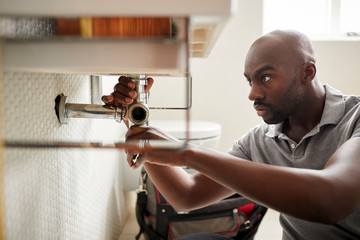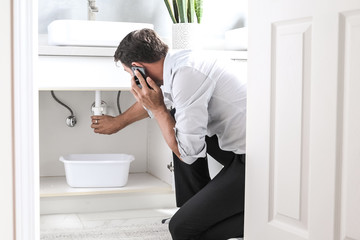How to Deal With an Emergency Plumber
It can be overwhelming when you have a plumbing emergency, such as raw sewage backing up into your toilets or water flooding into your home from busted pipes. An emergency plumber can help you with these issues quickly and effectively.
When searching for an emergency plumber, ensure they are licensed and insured. Also, ask about their typical response time to ensure they can get to you promptly. Contact Plumber Edison NJ for professional help.
Clogged drains are one of the biggest plumbing headaches that can cause a lot of pain in a short amount of time. These clogs can lead to standing water in the tub, sink, and toilet as well as odor-inducing sewer backups.
Most drain clogs form as a result of food waste, soap scum, hair, and grease sticking to the inside of pipes. This creates a sticky substance that will block any water flow. Over time, this can build up and become worse. Luckily, most drain clogs are fairly easy to fix without the need for a professional plumber.
The first thing you should try is pouring a few tablespoons of dish soap into the drain. If this doesn’t work, then it might be time to break out the plunger. Plunging can be very effective for small clogs, especially if you use it often and vigorously. If you don’t have a plunger, you can also try using a commercial drain cleaner that will dissolve and break up clogs.
Another option is to use a drain snake, which is available at most home improvement stores. This tool has a coiled wire that can be inserted into the drain to loosen and break up clogs. Once you’ve broken up the clog, simply flush the drain with hot water.
Getting to know your house’s plumbing systems can help you avoid the most common plumbing problems. While it may seem like your home’s plumbing is all connected, each part of the system has its own individual functions and components. Some of these can be impacted by other parts, so it’s important to learn more about how your plumbing works to prevent and repair problems as they arise.
Faulty Shut-Off
In an emergency plumbing situation, the first step is always to shut off your water supply. This is often done with a main valve that connects your house to the water company’s line, located either along your property’s curb or contained within a grate or box buried underground. While these are relatively low maintenance devices, they can get stuck or corrode over time and fail to stop the flow of water in an emergency.
The good news is, this is usually an easy repair for your plumber. However, it is important to check your shut-offs occasionally to make sure they are in working order. If you find a leaking shut off valve, it is best to fix it before the problem escalates into a major plumbing catastrophe.
If you notice a leak around the valve handle, it is likely occurring due to a worn sealing washer. In this case, you can try tightening the packing nut, which will help ensure it’s properly sealed when you turn on your water. If this doesn’t stop the dripping, it is probably best to replace the valve.
Every toilet, sink, and appliance in your home will have a small shut off valve for the purpose of cutting off their specific water supply and preserving water elsewhere in the house. Over time, these can also become seized or break, and will need to be replaced.
Leaking shut-offs are more common than you might think. The most common failure found with these valves is that they seize, meaning they can no longer be turned by hand. In some cases, this can be fixed with a bit of WD-40 and an adjustable wrench, but in others it may be necessary to have your plumber replace the valve entirely.
A leaking valve is often the result of water that is flowing over the stem of the water valve. This causes a build-up of deposits, which in turn leads to a leak. In this case, the solution is simple: loosen the bonnet nut, pull back the nut and expose the threaded spindle, wrap Teflon packing tightly around the spindle, then tighten the nut with an adjustable wrench. This is a quick and cheap DIY project for a plumber that can save you hundreds in potential water damage repairs.
Burst Pipes
A burst pipe is a homeowner’s worst nightmare. The damage it causes can lead to hundreds or even thousands of dollars in water repair costs. Fortunately, there are some steps homeowners can take to minimize the damage and keep the situation from getting worse while they wait for a plumber to arrive.
The first thing you should do if you suspect a pipe has burst is turn off the main water supply to your home. This will stop any new water from entering your house, which can make the problem a lot harder to deal with. It’s also a good idea to turn off any electric appliances in the area of the damage.
Next, you should call a plumber as soon as possible. This will ensure that they can get to your home quickly and prevent any further damage from occurring. When you call the plumber, be sure to let them know where the leak is located and what has happened to the pipe. This information will help them determine the best course of action to take.
It’s important to remember that actual pipe repairs are usually left to professional plumbers. However, there are some things you can do at home to minimize the impact of a burst pipe. Some of these steps are easy and only require a little knowledge of plumbing.
For example, if you notice any sudden drops in your water pressure, this is an indication that there may be a burst pipe somewhere nearby. You can also listen for any unusual noises coming from your pipes. Metallic clangs or rumbling sounds can indicate that there is a break in your pipe.
You can also try to prevent pipe bursts by insulating your pipes and keeping them warm. This will help protect them from freezing during the winter and reduce condensation buildup during the summer, which can both cause pipes to burst. Lastly, it’s always a good idea to schedule regular plumbing inspections with a professional. This will allow them to identify any potential problems before they become serious and save you money in the long run.
Sewage Backup
Sewage backups are among the most unpleasant and dangerous plumbing emergencies. Raw sewage contaminates your home with dangerous bacteria that can make you sick and cause irreparable damage to your walls, floors and belongings. This is why you need to call a professional right away if you notice any signs of a sewage backup.
The most obvious sign of a sewer problem is slow-moving drains throughout your home or business. You may also hear gurgling noises or notice a strong smell of rotten organic waste. If you can’t get a hold of an emergency plumber immediately, the best thing to do is shut off the main water supply valve to your home or business. This will stop more wastewater from entering the affected pipes and prevent it from backing up into your sinks, showers and toilets.
Sometimes, it’s not your sewer line that gets clogged, but the public sewer system that serves your area. Heavy rains can overwhelm the system and force sewage into homes through broken and damaged drain lines. This is why it’s so important to have your home’s drain lines inspected regularly and to replace any older pipes.
You can also help prevent sewer backups by never putting cooking grease down any drain or flushing anything but human waste and toilet paper. It’s best to have your drain lines inspected annually or every few years, so that any problems can be caught and fixed before they become a major issue.
One of the most common causes of a sewer backup is tree roots. If a large tree grows too close to a home’s drainage pipe, it can become entangled and block the line. You should have any trees around your house inspected periodically for root growth and remove any that are too close.
If you do experience a sewage backup, be sure to wear protective clothing like a face mask, eye protection, rubber boots and gloves. Stay out of the flooded area and shut off any electrical outlets that are wet or exposed to sewage. Once the sewage has been removed and the affected areas have been cleaned and restored, be sure to contact your insurance company to file a claim for any damages covered by your policy.


